Jeep Cherokee (XJ): Description and operation
DESCRIPTION 1 - POSITIVE POST A large capacity, low-maintenance storage battery
(Fig. 1) is standard factory-installed equipment on
this model. Male post type terminals made of a soft
lead material protrude from the top of the molded
plastic battery case to provide the means for connecting
the battery to the vehicle electrical system. The
battery positive terminal post is visibly larger in
diameter than the negative terminal post, for easy
identification. The letters POS and NEG are also
molded into the top of the battery case adjacent to
their respective positive and negative terminal posts
for additional identification confirmation. Refer to
Battery Cables in the index of this service manual
for the location of more information on the battery
cables that connect the battery to the vehicle electrical
system.
This battery is designed to provide a safe, efficient
and reliable means of storing electrical energy in a
chemical form. This means of energy storage allows
the battery to produce the electrical energy required
to operate the engine starting system, as well as to
operate many of the other vehicle accessory systems
for limited durations while the engine and/or the
charging system are not operating. The battery is
made up of six individual cells that are connected in
series. Each cell contains positively charged plate
groups that are connected with lead straps to the
positive terminal post, and negatively charged plate
groups that are connected with lead straps to the
negative terminal post. Each plate consists of a stiff
mesh framework or grid coated with lead dioxide
(positive plate) or sponge lead (negative plate). Insulators
or plate separators made of a non-conductive
material are inserted between the positive and negative
plates to prevent them from contacting or shorting against one another. These
dissimilar metal
plates are submerged in a sulfuric acid and water
solution called an electrolyte.
The factory-installed battery has a built-in test
indicator (hydrometer). The color visible in the sight
glass of the indicator will reveal the battery condition.
For more information on the use of the built-in
test indicator, refer to Battery in the index of this
service manual for the location of the proper battery
diagnosis and testing procedures. The factory-installed
low-maintenance battery has removable
battery cell caps. Water can be added to this battery.
The battery is not sealed and has vent holes in
the cell caps. The chemical composition of the metal
coated plates within the low-maintenance battery
reduces battery gassing and water loss, at normal
charge and discharge rates. Therefore, the battery
should not require additional water in normal service.
If the electrolyte level in this battery does
become low, water must be added. However, rapid
loss of electrolyte can be caused by an overcharging
condition. Be certain to diagnose the charging system
after replenishing the water in the battery for a low
electrolyte condition and before returning the vehicle
to service. Refer to Charging System in the index of
this service manual for the location of the proper
charging system diagnosis and testing procedures.
For battery maintenance schedules and jump starting
procedures, see the owner's manual in the vehicle
glove box. Optionally, refer to Maintenance Schedules
and Jump Starting, Towing and Hoisting in
the index of this service manual for the location of
the recommended battery maintenance schedules and
the proper battery jump starting procedures. While
battery charging can be considered a maintenance
procedure, the battery charging procedures and information
are located in the service procedures section
of this service manual. This was done because the
battery must be fully-charged before any battery
diagnosis or testing procedures can be performed.
Refer to Battery Charging in the index of this service
manual for the location of the proper battery
charging procedures.
NOTE: This group covers both Left-Hand Drive
(LHD) and Right-Hand Drive (RHD) versions of this
model. Whenever required and feasible, the RHD
versions of affected vehicle components have been
constructed as mirror-image of the LHD versions.
While most of the illustrations used in this group
represent only the LHD version, the diagnostic and
service procedures outlined can generally be
applied to either version. Exceptions to this rule
have been clearly identified as LHD or RHD, if a
special illustration or procedure is required. BATTERY SIZE AND RATINGS The battery Group Size number, the Cold Cranking
Amperage (CCA) rating, and the Reserve Capacity
(RC) rating or Ampere-Hours (AH) rating can be
found on the original equipment battery label. Be
certain that a replacement battery has the correct
Group Size number, as well as CCA, and RC or AH
ratings that equal or exceed the original equipment
specification for the vehicle being serviced. Refer to
Battery in the index of this service manual for the
location of the proper factory-installed battery specifications.
Battery sizes and ratings are discussed in
more detail below. OPERATION When an electrical load is applied to the terminals
of the battery, an electrochemical reaction occurs.
This reaction causes the battery to discharge electrical
current from its terminals. As the battery discharges,
a gradual chemical change takes place
within each cell. The sulfuric acid in the electrolyte
combines with the plate materials, causing both
plates to slowly change to lead sulfate. At the same
time, oxygen from the positive plate material combines
with hydrogen from the sulfuric acid, causing
the electrolyte to become mainly water. The chemical
changes within the battery are caused by the movement of excess or free
electrons between the positive
and negative plate groups. This movement of electrons
produces a flow of electrical current through
the load device attached to the battery terminals.
As the plate materials become more similar chemically,
and the electrolyte becomes less acid, the voltage
potential of each cell is reduced. However, by
charging the battery with a voltage higher than that
of the battery itself, the battery discharging process
is reversed. Charging the battery gradually changes
the sulfated lead plates back into sponge lead and
lead dioxide, and the water back into sulfuric acid.
This action restores the difference in the electron
charges deposited on the plates, and the voltage
potential of the battery cells. For a battery to remain
useful, it must be able to produce high-amperage current
over an extended period. A battery must also be
able to accept a charge, so that its voltage potential
may be restored.
The battery is vented to release excess hydrogen
gas that is created when the battery is being charged
or discharged. However, even with these vents,
hydrogen gas can collect in or around the battery. If
hydrogen gas is exposed to flame or sparks, it may
ignite. If the electrolyte level is low, the battery may
arc internally and explode. If the battery is equipped
with removable cell caps, add distilled water whenever
the electrolyte level is below the top of the
plates. If the battery cell caps cannot be removed, the
battery must be replaced if the electrolyte level
becomes low.
In addition to producing and storing electrical
energy, the battery serves as a capacitor and voltage
stabilizer for the electrical system of the vehicle. It
absorbs most abnormal or transient voltages caused
by the switching of any of the electrical components
in the vehicle. DESCRIPTION The battery cables (Fig. 2) are large gauge,
stranded copper wires sheathed within a heavy plastic
or synthetic rubber insulating jacket. The wire
used in the battery cables combines excellent flexibility
and reliability with high electrical current carrying
capacity. Refer to Wiring Diagrams in the index
of this service manual for the location of the proper
battery cable wire gauge information.
A clamping type female battery terminal made of
soft lead is die cast onto one end of the battery cable
wire. A square headed pinch-bolt and hex nut are
installed at the open end of the female battery terminal
clamp. Large eyelet type terminals are crimped
onto the opposite end of the battery cable wire and
then solder-dipped. The battery positive cable wires have a red insulating
jacket to provide visual identification
and features a larger female battery terminal
clamp to allow connection to the larger battery positive
terminal post. The battery negative cable wires
have a black insulating jacket and a smaller female
battery terminal clamp.
The battery cables cannot be repaired and, if damaged
or faulty they must be replaced. Both the battery
positive and negative cables are available for
service replacement only as a unit with the battery
wire harness, which may include portions of the wiring
circuits for the generator and other components
on some models. Refer to Wiring Diagrams in the
index of this service manual for the location of more
information on the various wiring circuits included in
the battery wire harness for the vehicle being serviced.
1 - BATTERY OPERATION The battery cables connect the battery terminal
posts to the vehicle electrical system. These cables
also provide a return path for electrical current generated
by the charging system for restoring the voltage
potential of the battery. The female battery
terminal clamps on the ends of the battery cable
wires provide a strong and reliable connection of the
battery cable to the battery terminal posts. The terminal
pinch bolts allow the female terminal clamps
to be tightened around the male terminal posts on
the top of the battery. The eyelet terminals secured
to the ends of the battery cable wires opposite the
female battery terminal clamps provide secure and reliable connection of the
battery to the vehicle electrical
system.
The battery positive cable terminal clamp is die
cast onto the ends of two wires. One wire has an eyelet
terminal that connects the battery positive cable
to the B(+) terminal stud of the Power Distribution
Center (PDC), and the other wire has an eyelet terminal
that connects the battery positive cable to the
B(+) terminal stud of the engine starter motor solenoid.
The battery negative cable terminal clamp is
also die cast onto the ends of two wires. One wire
has an eyelet terminal that connects the battery negative
cable to the vehicle powertrain through a stud
on the right side of the engine block. The other wire
has an eyelet terminal that connects the battery negative
cable to the vehicle body through a ground
screw on the right front fender inner shield, near the
battery. DESCRIPTION
1 - SCREW AND WASHER (1) The battery hold down hardware (Fig. 3) includes
two T-bolts with plastic push-on retainers, a hold
down bracket, a stamped steel battery support strap,
two hex nuts with coned washers and a single hex
screw with a coned washer. The battery hold down
bracket consists of a formed steel rod with a stamped
steel angle bracket welded to each end. The hold
down bracket assembly is then plastic-coated for corrosion
protection.
When installing a battery into the battery tray, be
certain that the hold down hardware is properly
installed and that the fasteners are tightened to the
proper specifications. Improper hold down fastener
tightness, whether too loose or too tight, can result in
damage to the battery, the vehicle or both. Refer to
Battery Hold Downs in the index of this service
manual for the location of the proper battery hold
down installation procedures, including the proper
hold down fastener tightness specifications. OPERATION The battery hold down hardware secures the battery
to the battery tray in the engine compartment.
The hold down support strap provides an additional
anchor point for the upper end of the battery and
hold down hardware at the upper radiator crossmember.
This hardware is designed to prevent battery
movement during vehicle operation. Unrestrained
battery movement during vehicle operation can
result in damage to the vehicle, the battery or both.
The hold down T-bolts are installed onto the battery
tray before the tray is installed in the engine
compartment. The T-bolts are inserted through a hole
in a molded formation integral to each side of the
battery tray from underneath, with the threaded
ends of the bolts extending upward. A plastic push-on
retainer is installed over each T-bolt to secure the
T-bolts to the battery tray for ease of assembly during
the vehicle manufacturing process. However,
these plastic push-on retainers are not available or
required for service replacement.
The battery hold down bracket is installed across
the top of the battery case and over the two upright
threaded ends of the T-bolts. The round hole in the
support strap is then installed over the threaded end
of the forward T-bolt and the slotted hole of the strap
is secured by a screw with washer to the upper radiator
cross member. A hex nut with coned washer is
then installed and tightened onto each of the T-bolts
to securely hold down the battery in the battery tray. DESCRIPTION
1 - THERMOGUARD A flexible plastic bubble-wrap style thermoguard
(Fig. 4) slides over the battery case to enclose the
sides of the battery. The thermoguard consists of a
heavy black plastic outer skin and two lighter plies of
plastic that have been formed into a sheet with hundreds
of small air pockets entrapped between them.
The resulting material is very similar to the bubblewrap
used to protect items in many parcel packaging
and shipping applications. OPERATION The thermoguard protects the battery from engine
compartment temperature extremes. The air trapped
between the plastic plies of the thermoguard create a
dead air space, which helps to insulate the sides of
the battery case from the surrounding engine compartment
air temperature. DESCRIPTION The battery is mounted in a molded plastic tray
(Fig. 5) located in the right front corner of the engine
compartment. Two T-bolts that are part of the battery
hold down hardware are assembled to the battery
tray before the tray is installed in the vehicle.
The battery tray is secured by three hex nuts with
coned washers to three weld studs located on the
front extension of the right front wheelhouse inner
panel, forward of the right front wheel.
A hole in the bottom of the battery tray is fitted
with a battery temperature sensor. Refer to Battery
Temperature Sensor in the index of this service manual for the location of more
information on the
battery temperature sensor. Refer to Battery Hold
Downs in the index of this service manual for the
location of more information on the battery hold
down hardware.
1 - TRAY OPERATION The battery tray provides a mounting location and
support for the vehicle battery. The battery tray also
provides anchor points for the battery hold down
hardware. The battery tray and the battery hold
down hardware combine to secure and stabilize the
battery in the engine compartment, which prevents
battery movement during vehicle operation. Unrestrained
battery movement during vehicle operation
can result in damage to the vehicle, the battery or
both.Battery
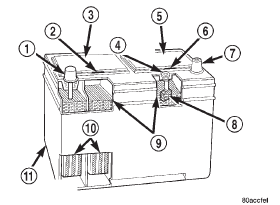
2 - VENT
3 - CELL CAP
4 - TEST INDICATOR
5 - CELL CAP
6 - VENT
7 - NEGATIVE POST
8 - GREEN BALL
9 - ELECTROLYTE LEVEL
10 - PLATE GROUPS
11 - LOW-MAINTENANCE BATTERY
The outside dimensions and terminal placement of
the battery conform to standards established by the
Battery Council International (BCI). Each battery is
assigned a BCI Group Size number to help identify a
correctly-sized replacement.
The Cold Cranking Amperage (CCA) rating specifies
how much current (in amperes) the battery can
deliver for thirty seconds at -18 C (0 F). Terminal
voltage must not fall below 7.2 volts during or after
the thirty second discharge period. The CCA required
is generally higher as engine displacement increases,
depending also upon the starter current draw
requirements.
The Reserve Capacity (RC) rating specifies the time
(in minutes) it takes for battery terminal voltage to
fall below 10.5 volts, at a discharge rate of 25
amperes. RC is determined with the battery fullycharged
at 26.7 C (80 F). This rating estimates how
long the battery might last after a charging system
failure, under minimum electrical load.
The Ampere-Hours (AH) rating specifies the current
(in amperes) that a battery can deliver steadily for
twenty hours, with the voltage in the battery not falling
below 10.5 volts. This rating is also sometimes
identified as the twenty-hour discharge rating.Battery cables
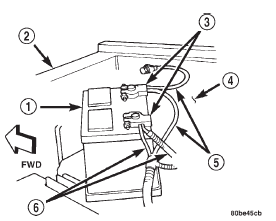
Fig. 2 Battery Cables
2 - RADIATOR CROSSMEMBER
3 - TERMINAL CLAMPS
4 - FENDER INNER SHIELD
5 - NEGATIVE CABLE
6 - POSITIVE CABLEBattery hold downs
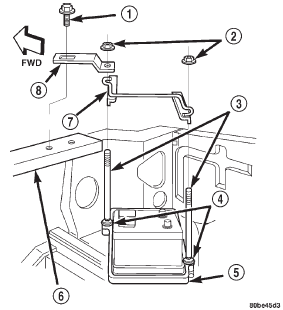
Fig. 3 Battery Hold Downs
2 - NUT AND WASHER (2)
3 - T-BOLT (2)
4 - RETAINER (2)
5 - BATTERY TRAY
6 - UPPER RADIATOR CROSS MEMBER
7 - BRACKET
8 - STRAPBattery thermoguard
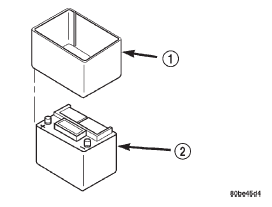
Fig. 4 Battery Thermoguard
2 - BATTERYBattery tray
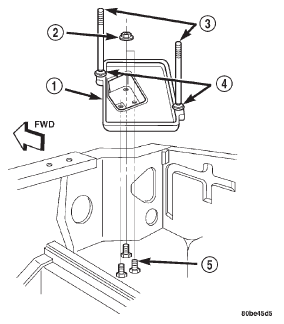
Fig. 5 Battery Tray
2 - NUT AND WASHER (3)
3 - T-BOLT (2)
4 - RETAINER (2)
5 - WELD STUD (3)
Other materials:
Emission system. Malfunction indicator lamp (mil). State display test mode
Emission system
OPERATION
The Powertrain Control Module (PCM) monitors
many different circuits in the fuel injection, ignition,
emission and engine systems. If the PCM senses a
problem with a monitored circuit often enough to
indicate an actual problem, it stores a Diagnostic
Trouble Code (DTC ...


